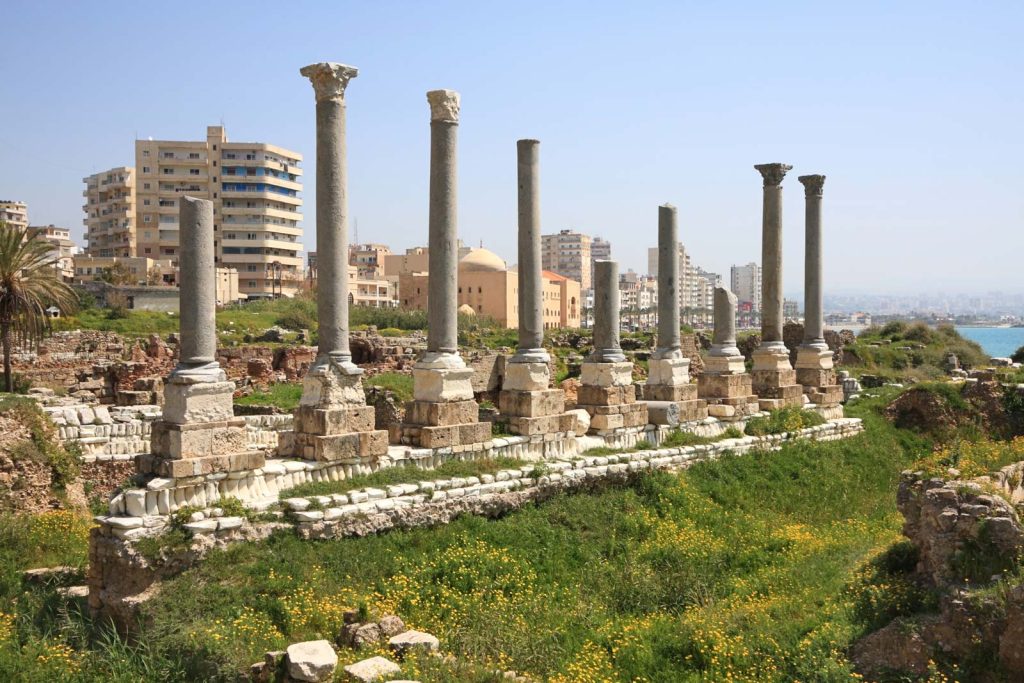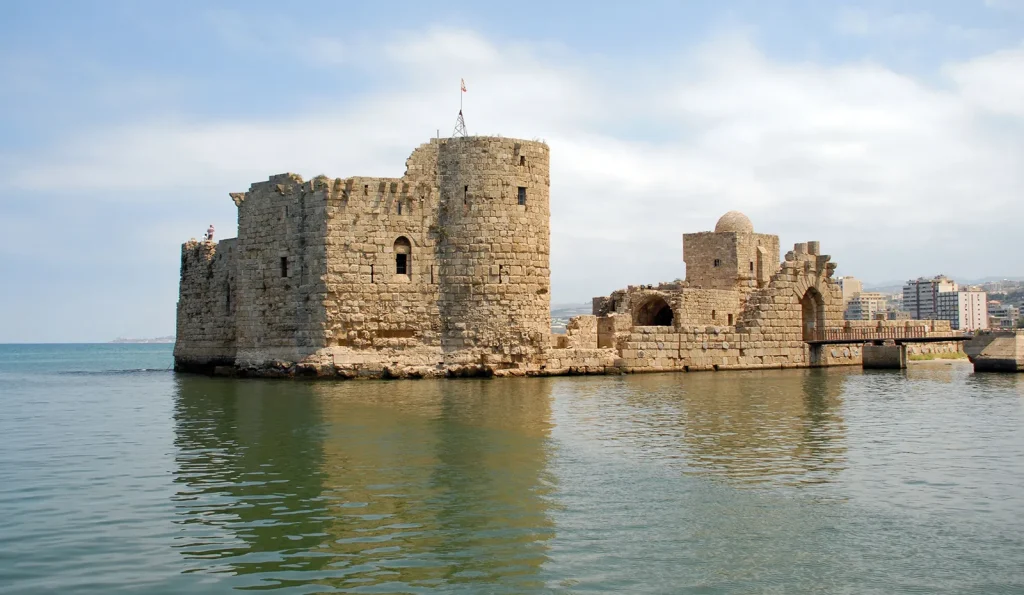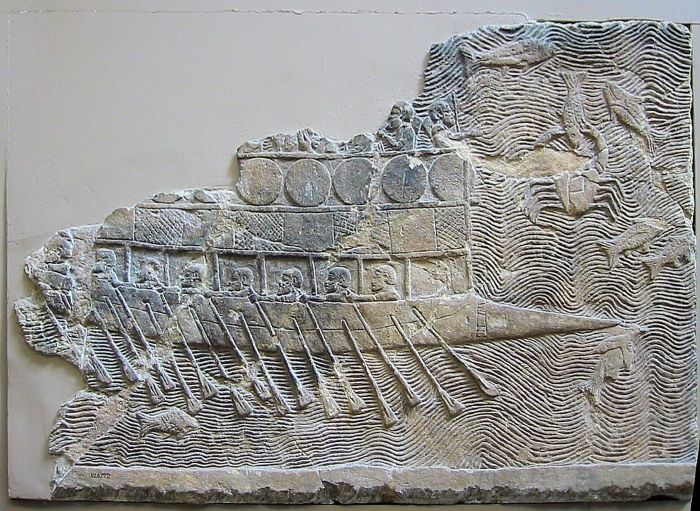ផូនីស្យា (Phoenicia) គឺជាអរិយធម៌មួយដែលកកើតឡើងពីរដ្ឋឯករាជ្យ (City-states) ចំនួន០៤ រួមបញ្ចូលគ្នាដែលស្ថិតនៅក្នុងតំបន់សមុទ្រមីឌីទែរ៉ាណេ។ រដ្ឋទាំង០៤នោះ រួមមាន Tyre , Sidon , Byblos និង Baalbek ហើយសព្វថ្ងៃជាប្រទេស លីបង់ (Lebanan), ផ្នែកខ្លះនៃស៊ីរី (Syria) និងផ្នែកខ្លះខាងជើងប្រទេសអ៊ីស្រាអែល (Northern Israel)។

អរិយធម៌នេះកកើតដំបូងឡើងនៅប្រមាណស.វ.ទី២ មុនគ.ស. ( ឆ្នាំ ១៥០០មុនគ.ស.) ដែលជាអរិយធម៌ និងអាណាចក្រដ៏ធំមួយនៅក្នុងតំបន់សមុទ្រមីឌីទែរ៉ាណេ។ ជនជាតិ ផូនីស្យា ត្រូវបានគេដឹងថាជាប្រជាជនដែលពូកែខាងដើរសមុទ្រ ក្នុងការជួញដូរ ធ្វើសង្គ្រាម ជាដើម។ ចំពោះឈ្មោះ ផូនីស្យា (Phoenicia) នេះគឺចេញពីពាក្យ phoenix ក្នុងភាសាក្រិចបុរាណដែលមានន័យថាពណ៌ស្វាយ-ក្រហម ហើយសំដៅលើជនជាតិផូនីស្យា ‘purple people’។ ប្រព័ន្ធរដ្ឋបាលនៃអរិយធម៌នេះ គឺស្រដៀងទៅនឹងអរិយធម៌ក្រិច ដែរ ដោយពុំមានរដ្ឋបាលកណ្តាល គឺមានតែការគ្រប់គ្រងដោយរដ្នឯករាជ្យទាំង៤។ ក្នុងចំណោមក្រុងទាំង៤នោះ ក្រុង Tyre, Sidon មានឥទ្ឋិពលខ្លាំងជាងគេផ្នែកនយោបាយ និងសេដ្ឋកិច្ច។ រីឯក្រុង Byblos និង Baalbek គឺជារដ្ឋដែលសំខាន់ៗខាងផ្នែកវប្បធម៌ និងសាសនា។ គួរបញ្ជាក់ដែរថា សំណង់ស្ថាបត្យកម្ម វប្បធម៌ សាសនា នៃអរិយធម៌ផូនីស្យានេះគឺទទួលឥទិ្ធពលពីអរិយធម៌ក្រិចស្ទើតែទាំងស្រុង។

ទីក្រុង Tyre មានទីតាំងស្ថិតនៅខាងត្បូងនៃប្រទេសលីបង់ និងមានចម្ងាយប្រមាណជាង៨០គីឡូពីរាជធានី Beirut។ ទីក្រុងត្រូវបានកសាងឡើងនៅអំឡុងស.វ.ទី៣មុនគ.ស. ពោលកសាងក្នុងឆ្នាំ ២៧៥០មុនគ.ស. និងត្រូវបានដាក់បញ្ចូលក្នុងបេតិកភ័ណ្ឌពិភពលោកនៅក្នុងឆ្នាំ១៩៨៤។ សំណង់ស្ថាបត្យកម្មនៅទីនេះ គឺដូចបានបញ្ជាក់ខាងលើហើយថា ជាឥទ្ធិលនៃអរិយធម៌ក្រិច ដែលកសាងជាសសរទាំង៣ដូចនឹងរចនាបទនៅក្រិច ឬរ៉ូមាំងសម័យបុរាណ។ Sidon គឺជាឈ្មោះក្នុងភាសាក្រិច និងក៏ជាទីក្រុងដ៏សំខាន់នៃអរិយធម៌ផូនីស្យា។ ទីក្រុងនេះ មានទីតាំងស្ថិតនៅខាងជើងនៃប្រទេសលីបង់ និងមានចម្ងាយប្រមាណជាង២០គីឡូពីរាជធានី Beirut។ ទីក្រុងនេះកកើតដំបូងនៅស.វ.ទី ៣មុនគ.ស. និងបានក្លាយជាតំបន់ពាណិជ្ជកម្មដ៏សំខាន់ក្នុងអរិយធម៌ផូនីស្យានាស.វ.ទី ៧មុនគ.ស។ សំណង់ស្ថាបត្យកម្មបុរាណជាច្រើនត្រូវបានរកឃើញនៅក្នុងតំបន់មួយហៅថា Byblos ដែលជាទីក្រុងចាស់ជាងគេនៅក្នុងអរិយធម៌ផូនីស្យា ពោលមានការតាំងទីរស់នៅតាំងពីយុគថ្មបំបែក និងអំឡុងចុងស.វ.ទី ៤មុនគ.ស. តំបន់នេះបានក្លាយជាទីក្រុងផ្នែកសាសនាដ៏សំខាន់មួយនៅក្នុងអរិយធម៌ផូនីស្យា។ ចំណែកឯទីក្រុង Baalbek គឺជាទីក្រុងដែលត្រូវបានគេដឹងថាទីក្រុងដ៏សំខាន់ជាងគេខាងផ្នែកសាសនានៅក្នុងសម័យ Hellenistic ដែលជាសម័យកាលនៃការស្លាប់របស់ Alexander the Great ក្នុងតំបន់សមុទ្រមីឌីទែរ៉ាណេ ហើយជាទីក្រុងដែលត្រូវបានអាណាចក្ររ៉ូមាំងគ្រប់គ្រង។ នៅទីនេះសំណង់ស្ថាបត្យកម្មជាច្រើនសុទ្ធសឹងតែជាអរិយធម៌ Greco-Roman ជាពិសេសសំណង់សសរដ៏ធំ ដែលឃើញមាននៅតាមប្រាសាទ ព្រះវិហារ និងសំណង់សាធារណៈផ្សេងៗទៀត។ ជនជាតិផូនីស្យាពូកែខាងផ្នែកសិល្បៈ ជាពិសេស រូបបដិមា/រូបចម្លាក់ជាដើម។

រាល់ទន្និន័យទាំងអស់ដែលបានបង្ហាញខាងលើ និងតាមរយៈសំណង់ស្ថាបត្យកម្ម សិល្បៈដែលបានបន្សល់ពីអរិយធម៌នេះបានបង្ហាញថា អរិយធម៌ផូនីស្យាត្រូវបានគេស្គាល់ថា ជាអរិយធម៌ដែលមានឥទ្ធិពលខ្លាំងក្លានៅក្នុងតំបន់សមុទ្រមីឌីទែរ៉ាណេ មានអាយុកាល ចាប់ពីឆ្នាំ ១៥០០មុនគ.ស. និងត្រូវបានដួលរលំនៅឆ្នាំ៣០០មុនគ.ស. ដោយអាណាចក្រក្បែរដែលរួមមាន Cyrus, ក្រិច និងរ៉ូមាំងជាដើម៕
————————————————————
Phoenicia civilization
Phoenicia is a civilization among four integrated independent city-states located in the Mediterranean Sea. The four states are Tyre, Sidon, Byblos, and Baalbek which are today Lebanon, part of Syria, and part of Northern Israel.
This civilization first appeared in 1500 BC which was a great civilization and empire in the Mediterranean Sea. The Phoenicians are known for their maritime trade, battle, and so on. The name Phoenicia is derived from the ancient Greek word phoenix, which means purple-red, and refers to the Phoenicians ‘purple people’. The administrative system of this civilization was similar to that of the five Greek civilizations, with no central administration, only the rule of the four independent city-states. Of the four cities, Tire and Sidon are the most politically and economically influential, whereas Byblos and Baalbek are important cultural and religious states. It should be noted that the architecture, culture, religion of the Phoenicia civilization was almost entirely influenced by the Greek civilization.
Tyre is located in southern Lebanon, more than 80 km from Beirut city. The city was built during the 3rd century BC, in 2750 BC, and was designated in the World Heritage List in 1984. The architectural structures here, as mentioned above, are influenced by Greek civilization, built on three columns that are similar in the style of ancient Greek or Roman. Sidon is a Greek name and also the city of the Phoenicia civilization. The city is located in the north of Lebanon, more than 20 km from Beirut. The city was first derived in the 3rd century BC and became an important trading area in the Phoenicia civilization in the 7th century BC. Many ancient architectural structures have been found in an area called Byblos, the oldest city in the Phoenicia civilization, dating to the Stone Age and during the late 4th century BC. The area became an important religious city in the Phoenicia civilization. Baalbek, on the other hand, was well known as the most important religious city in the Hellenistic period, which is the period of the death of Alexander the Great in the Mediterranean Sea, and was ruled by the Roman Empire. Many of the architectural structures here are Greco-Roman civilization, especially the large pillars found in the temples, churches, and other public buildings. The Phoenicians are expertise in the arts, especially statues/sculptures, etc.
All the above data and the architectural and artistic remnants in this civilization show that the Phoenicia civilization is known as the most influential civilization in the Mediterranean Sea, dating back to 1500 BC and was collapsed in 300 BC by nearby kingdoms including Cyrus, Greece, and Roman.
អត្ថបទដើម៖ លោក អេង តុលា






